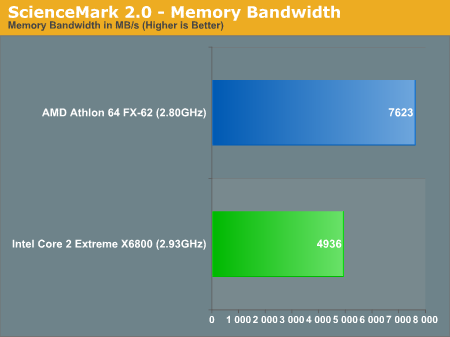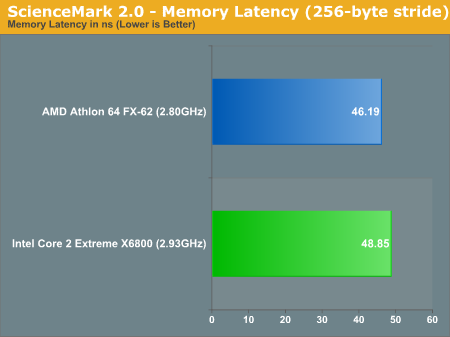Intel Core 2 Extreme X6800 Preview from Taiwan
by Anand Lal Shimpi & Gary Key on June 6, 2006 7:35 PM EST- Posted in
- CPUs
Memory Latency and Bandwidth
We've never been able to look at some of the low level characteristics of Intel's Core architecture, and although we didn't have enough time to do a thorough run of low level benchmarks we were able to run ScienceMark 2.0 in order to get an idea of how the Core 2 Extreme stacked up against the FX-62 in terms of memory latency and bandwidth.
We had seen Conroe performance results that showed the new architecture being able to offer fairly competitive memory access latencies to AMD's architecture, without the need of an on-die memory controller. Our ScienceMark 2.0 results confirm just that:
While AMD still offers lower memory latency, the Core 2 Extreme X6800 is very close in comparison - especially considering that it has no on-die memory controller. With lower clock speeds than its Pentium D siblings and a faster FSB, memory access latency is reduced tremendously with Conroe. On a larger scale, through a very effective cache subsystem as well as memory disambiguation, Conroe can offer significantly improved memory performance compared to its predecessors, including the Athlon 64 X2/FX.

ScienceMark's memory bandwidth results offer a very telling story, showing us the bandwidth limitations of Intel's FSB architecture. While the FX-62's peak theoretical bandwidth is not achieved in real world, you can see how AMD's Direct Connect architecture offers higher limits for chip-to-chip communication.











134 Comments
View All Comments
poohbear - Tuesday, June 6, 2006 - link
so from a gamers perspective, and im guessing gamers are the only ones that care for the bleeding edge, does this cpu do anything for performance in games @ 1280x1024+ resolutions?Gary Key - Thursday, June 8, 2006 - link
Yes, our tests were run at a lower resolution to keep the GPU from being a "bottleneck" to a certain degree. The performance differences in a couple games at 1600x1200 were slightly better for Conroe than at the 1024x768 setting. We did not have enough time with the 965 board to complete our test suite, but that will be coming in the near future. :-)
vailr - Tuesday, June 6, 2006 - link
Any rumors of when Apple's Conroe based Intel Mac will be released?That is: the full-fledged, 64 bit, desktop Mac (replacement for the dual-CPU G5 machine).
saratoga - Tuesday, June 6, 2006 - link
Though "full-fledged, 64 bit" will have to wait a little while until Apple launches a new MacOS version that has 64 bit support. Not that it really matters right now anyway, since 4GB is still enough for most users, and they should be ready in time for these people.saratoga - Tuesday, June 6, 2006 - link
Probably about the same time as Conroe launches. Apple is unlikely to sit around while Dell tempts their customers with fast, lower power CPUs. I imagine Apple will probably treat CPUs like they do GPUs. That is, when something substantially better comes out, they'll time it to launch a new tower/laptop/whatever so they don't get caught selling older hardware.flurazepam - Tuesday, June 6, 2006 - link
Server lost my last post! Hope it doesn't come up twice! Reiterating what I previously wrote. I'm currently in Taipei and have had the chance to test both the X6800 and the FX-62. Neither "feel" faster than either in normal use, but both "feel" significantly faster than the Pentium DEE. Using low resolution gaming, Conroe runs about 20% faster than the AMD, give or take a few percent. The chap at Intel also said that the Intel chip is not faster in every game or app. There a few apps that AMD can take over Intel. What needs to be done is testing using multithreaded apps run in a multiapp environment. In any case, Intel has a winner here.JarredWalton - Wednesday, June 7, 2006 - link
Quake 4 has SMP support, and it was enabled. SysMark2004 also does some multitasking. Getting a proper multitasking test configured and run takes quite a bit more time, unfortunately, so when given the choice of testing 6-8 applications vs. one multitasking setup, we have to currently settle for the former. In a few more months, we'll of course do our best to provide comprehensive testing. "One night in Bangkok..." er... Taiwan is not the best for getting every ounce of information we would like. :)flurazepam - Tuesday, June 6, 2006 - link
Apologies if this post comes up twicethestain - Tuesday, June 6, 2006 - link
LOL.. Just want to see more test.. Anand and the gang.. I wish I was there!! Please no offense on my posts.. just trying to stir the humor pot a little..But.. is there some real world application that would put Conroe's FSB memory limit to the test and where AM2 would then perform better, because if not.. it is going to be a cold, dark summer and fall for AMD.
bob661 - Tuesday, June 6, 2006 - link
AM2 was NEVER meant to be a performance boost so to expect anything more is idiotic! Of course, Conroe would outperform AM2 as it is a new design with new improvements. AM2 is just DDR2 on the present tech. Considering that Conroe is all new tech, I expected even GREATER performance from the new platform. Either way, we now have a fair amount of choices when it comes to CPU's. I can now recommend Intel processors to my cusatomers (well I can recommend them next year when prices go down and there are more mid and low end Conroe's available).